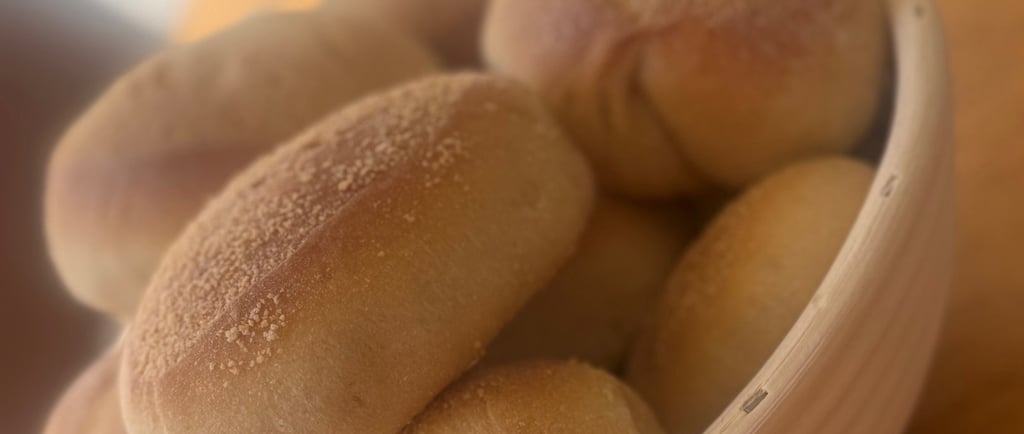The Evolution of Pandesal: How the Philippines' Beloved Bread Roll Has Transformed in Taste
Pandesal has journeyed from a salty, dense Spanish roll baked in wood-fired ovens to a soft, lightly sweet Filipino staple with a milky aroma and golden breadcrumb crust. Over centuries, American sugar, wartime substitutions, and modern flavors like ube or sourdough have softened its bite and layered new tastes—yet its warm, comforting essence endures in every dawn queue at the panadería.
Lola Inay
11/6/20253 min read


Pandesal, the humble yet iconic bread roll of the Philippines, is more than just a breakfast staple—it's a cultural touchstone. Derived from the Spanish pan de sal (literally "salt bread"), this soft, pillowy roll with its signature dusty topping has graced Filipino tables for over a century. But its taste has not remained static. From colonial introductions to modern innovations, pandesal's flavor profile has evolved dramatically, reflecting shifts in ingredients, baking techniques, socioeconomic changes, and global influences. This article traces that flavorful journey, revealing how a simple bread became a mirror of Philippine history.
Colonial Origins: The Salty Spanish Beginnings (16th–19th Centuries)
Pandesal's story begins with Spanish colonization in the 16th century, when wheat-based breads were introduced to a rice-centric archipelago. Early versions were closer to European salt breads: dense, chewy loaves made with wheat flour, water, yeast, salt, and sometimes lard. The "sal" in pandesal referred to its pronounced saltiness, a preservative in the tropical heat and a nod to Spanish pan de sal recipes.
Taste-wise, these were savory and straightforward—salty with a subtle yeasty tang, no sweetness to speak of. Baked in wood-fired pugon ovens, they had a crisp crust and a slightly smoky undertone from the fuel. Indigenous adaptations emerged quickly; Filipinos incorporated local lard or coconut oil for richness, but the core flavor remained austere. Historical accounts from the 1800s describe pandesal as a working-class food, sold by street vendors at dawn, pairing perfectly with coffee or tsokolate (thick hot chocolate). It wasn't indulgent; it was fuel.
American Influence and the Sweet Shift (Early 20th Century)
The turning point came with American rule (1898–1946). U.S. forces brought refined wheat flour, sugar, and modern baking equipment, transforming pandesal into something sweeter and softer. Bakeries like the iconic Panadería de Manila experimented with enriched doughs, adding sugar, milk powder, and shortening.
By the 1920s–1930s, the modern pandesal emerged: lightly sweet with a milky aroma, balanced by a hint of salt. The crust softened, and the interior became fluffier thanks to commercial yeast and electric ovens. This sweetness wasn't overpowering—about 5–10% sugar in recipes—but it marked a departure from the salty original. Why the change? American palates favored sweeter breads, and post-WWII reconstruction made sugar more accessible. Pandesal became a symbol of resilience; during shortages, bakers stretched flour with rice or cassava, subtly altering the taste to something earthier and less refined.
Post-Independence Boom: Mass Production and Regional Twists (1950s–1980s)
Independence in 1946 spurred a bakery boom. Chains like Goldilocks and local panaderías standardized pandesal, but regional variations flourished. In Manila, it stayed mildly sweet and uniform; in the Visayas, bakers added more lard for a buttery richness; in Mindanao, coconut milk infused a tropical nuttiness.
The 1970s oil crisis and martial law under Marcos introduced substitutions: margarine replaced butter, powdered milk stood in for fresh. Taste evolved toward convenience—still sweet-salty, but with a synthetic edge from preservatives. Yet, the classic profile solidified: a golden-brown roll dusted with breadcrumbs, tasting of warm dough, faint vanilla from milk, and that addictive salty crunch on top. It was now paired with everything from palaman (fillings) like cheese, corned beef, or peanut butter, amplifying its versatility.
Globalization and Health Trends (1990s–2010s)
The 1990s brought imported ingredients and fast-food culture. Supermarket pandesal from brands like Gardenia was pre-packaged, softer, and sweeter (up to 15% sugar) for longer shelf life. Artificial flavors crept in—vanilla essence, dough conditioners—making it taste more uniform but less artisanal.
Health consciousness in the 2000s sparked "healthy" variants: whole wheat pandesal with a nuttier, grainier bite; low-sugar versions retaining saltiness but losing sweetness. Ube (purple yam) pandesal exploded in popularity, adding a creamy, earthy sweetness; malunggay (moringa) versions brought a herbal green note. Fusion experiments included cheese-filled rolls with a sharp, melty tang or pandesal burgers with savory fillings. Globalization introduced sourdough techniques, yielding tangier, more complex flavors in upscale bakeries.
Modern Innovations: Artisanal Revival and Sustainability (2020s–Present)
Today, pandesal is in a renaissance. The COVID-19 pandemic revived home baking, with sourdough pandesal trending on social media—fermented for 12–24 hours, it develops a tangy, umami depth absent in quick-rise versions. Artisanal bakers like those at Wildflour or The Panaderia use heritage wheat, resulting in deeper, wheatier flavors with notes of caramel from high-heat baking.
Sustainability drives change: ancient grains like red rice or quinoa add nutty, robust tastes; plant-based milks create vegan pandesal with coconut or almond undertones. Flavored innovations abound—pandesal with truffle oil for earthy luxury, or spicy chili variants with a fiery kick. Yet, the core taste endures: that perfect sweet-salty balance, now customizable.
In 2025, a classic pandesal might taste like this: softly sweet (from cane sugar), milky (evaporated milk), with a salty breadcrumb crust and yeasty warmth. But bite into a modern twist, and you might encounter bold new layers.
Conclusion: A Bread That Keeps Rising
From salty Spanish import to sweet Filipino icon, pandesal's taste evolution mirrors the nation's adaptability. What started as a basic, briny roll has sweetened, softened, and diversified, influenced by colonizers, crises, and creativity. Today, whether from a corner panadería at 5 AM or a gourmet café, pandesal remains a daily ritual—proof that even the simplest foods evolve with the times. Next time you tear one open, savor the history in every crumb.